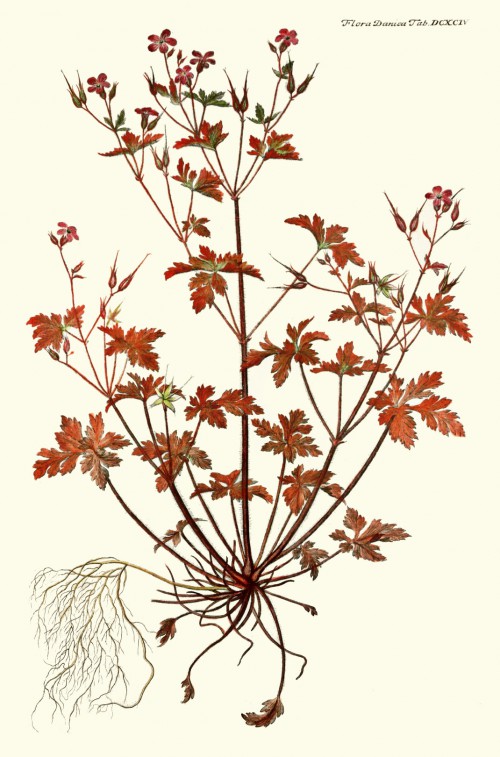Geranium robertianum L. - Geraniaceae - herb Robert, mountain geranium, Ruprechtskraut, Stink-Storchschnabel, Stinkender Storchschnabel
Annual or biennial herb, 10-50cm tall, native to the northern temperate regions; leaves opposite, palmately divided, 3-9cm long, pilose with ± appressed glandular trichomes; segments 5, rhombic, with a petiolule on middle segment; cymules solitary, 2-flowered; petals five, purplish, 7-10 mm, staminal filaments pinkish, anthers purplish, 0.4-0.6 mm; fruit 2cm, erect when immature.
http://www.efloras.org/florataxon.aspx?flora_id=2&taxon_id=200012398
Stem and leaves are often deeply red coloured by photoprotective pigments, hence the name herb Robert.
https://de.wikipedia.org/wiki/Ruprechtskraut
Geranium robertianum bears three types of glandular trichomes which originate from a single protodermal cell. Type I and type II trichomes are common on leaves and secrete terpenoids and phenols, while III trichomes are more abundant on flower structures and are characterized by the accumulation of anthocyanins in the apical cell and secrete flavonoids.
[Morphology, ontogeny and histochemistry of secretory trichomes of Geranium robertianum (Geraniaceae)., Pedro, L., Campos, P., Pais, M.S., Nordic journal of botany, 10(5), 1990, 501-509]
Aerial parts of Geranium robertianum contain tannins (10.8%) and several flavonoids of quercetin and kaemferol.
[Flavonoide aus den oberirdischen Teilen von Geranium robertianum., Kartnig, T., Bucar-Stachel, J., Planta medica, 57(03), 1991, 292-293]
Major components of the essential oil from the aerial parts of Geranium robertianum L. (hydrodistillation, 0.03%) were linalool (22.9%), γ-terpinene (13.9%), germacrene-D (7.8%), limonene (5.3%), geraniol (4.4%), α-terpineol (3.8%), phytol (3.8%), myrcene (3.3%), tricyclene (2.2%), nerol (1.5%) and α-thujene (1.0%). Minor components were eg. benzaldehyde (0.1%), camphene (0.2%), borneol (0.1%), isoborneol (0.4%), and cis-jasmone (0.1%).
[Composition of the essential oil of geranium robertianum L., Pedro, L.G., Pais, M., Scheffer, J.J., Flavour and fragrance journal, 7(4), 1992, 223-226]
The dried aerial parts of the herb (Geranii robertiani herba, Herba Robertiani, Blutkraut, Rotlaufkraut) is used in traditional medicine as anti-inflammatory, andi-diarrhoeal to treat infections of the urinary tract and mild diarrhoea; externally to cure slowly healing wounds, eczema and mucosal inflammations. As the plant is rich in tannins, which are astringent and have antiseptic and anti-inflammatory effects, effectiveness in application areas seems plausible.
[Medicinal Plants of the World. Ben-Erik Van Wyk and Michael Wink, Pretoria 2004, 156]
[Hagers Handbuch der Pharmazeutischen Praxis, Springer 2010]
The most abundant compounds in essential oil from the aerial parts (yield 0.006%) of G.robertianum were hexadecanoic acid (16.6%), hexahydrofarnesyl acetone (6.5%) and caryophyllene oxide (5.4%). Linalool (1.4%) and geraniol (traces) were only minor components. γ-Terpinene, germacrene D, and limonene were not even detected.
Main components of the root oil (yield 0.042%) were hexadecanoic acid (45.3%), pentacosane (28.5%), and tetracosane (8.9%).
[Chemical composition and antimicrobial activity of the volatile oils of Geranium sanguineum L. and G. robertianum L.(Geraniaceae)., Radulović, N., Dekić, M., Stojanović-Radić, Z., Medicinal Chemistry Research, 21(5), 2012, 601-615]

Flora Danica [G.C. Oeder et al], f.12, t.694 (1761-1883)
http://plantgenera.org/species.php?id_species=462922